
- •Basic Functions : fixed
- •Paste Special II - Removing formulae
- •Secret StarWars games
- •Using Names as constants
- •Listing Cell Notes
- •Basic functions: choose
- •Checkerboard shading
- •Using Pop Up Notes in Cells
- •Macros: Text Utilities Part I
- •Adding a dialog: Part I
- •Adding a dialog: Part II
- •Formatting ratios
- •Filling a multiplication chart
- •Macros: Text Utilities Part I
- •Summing across sheets
- •Counting unique entries in a range
- •Spelling out numbers
- •Datapilot Revisited
- •DataPilot Revisited II
- •Basic functions: text
- •Ranking and sorting data I
- •Conditional summation revisited
- •Regression analysis I : Basic linear formulas
- •Regression Analysis II : Basic functions, charting
- •Regression Analysis III : linest
- •Rounding to the nearest nickel: mround()
- •Looking up data in tables V
- •Combining data in cells
- •Rounding functions I
- •Easter formula
- •Date & Time : Calculating Dates of Holidays
- •Financial Functions 3 : Complex Accumulation
- •Data Consolidation 101
- •Basic Functions: frequency
- •Largest values in an array
- •Advanced Functions: indirect
- •Counting letters in a string
- •Macro : Sorting sheets
- •Basic functions : subtotal
- •Filling a Cell Range with a Series
- •Converting text to dates
- •Basic Functions : cell
- •Rounding Numbers to Thousands and Millions
- •Text manipulation 1 : Concatenation
- •Copying Formulas while preserving references
- •Sumproduct and conditional summation
- •Custom Time Formatting for a timesheet
- •Data Validation 101
- •Basic functions : sumif
- •Adding a background graphic
- •Introduction to the Status Bar » Using the Navigator
- •Introduction to the Status Bar
- •Charting: Editing charts : part 2
- •Charting: Editing charts : part 3
- •Autocorrect
- •Macros: Getting Cell Information
- •Charting: Pie charts
- •One Response to “Charting: Pie charts”
- •Basic Functions: iserr
- •Database functions: daverage
Basic Functions : FIXED 3
Paste Special II - Removing formulae 4
Secret StarWars games 4
Using Names as constants 6
Listing Cell Notes 7
Basic functions: CHOOSE 10
Checkerboard shading 10
Using Pop Up Notes in Cells 11
Macros: Text Utilities Part I 12
Adding a dialog: Part I 16
Adding a dialog: Part II 21
Formatting ratios 25
Filling a multiplication chart 26
Macros: Text Utilities Part I 28
Summing across sheets 33
Counting unique entries in a range 34
Spelling out numbers 34
Datapilot Revisited 38
DataPilot Revisited II 41
Splitting a string into characters 43
Basic functions: TEXT 43
Ranking and sorting data I 44
Conditional summation revisited 45
Regression analysis I : Basic linear formulas 46
Regression Analysis II : Basic functions, charting 47
Regression Analysis III : LINEST 50
Rounding to the nearest nickel: MROUND() 51
Looking up data in tables V 52
Combining data in cells 52
Rounding functions I 53
Easter formula 53
OpenOffice Calc Tips 54
Date & Time : Calculating Dates of Holidays 54
Financial Functions 3 : Complex Accumulation 56
Data Consolidation 101 58
Basic Functions: FREQUENCY 60
Largest values in an array 61
Advanced Functions: INDIRECT 62
Counting letters in a string 63
Macro : Sorting sheets 63
Basic functions : SUBTOTAL 64
Filling a Cell Range with a Series 66
Converting text to dates 68
Basic Functions : CELL 68
Rounding Numbers to Thousands and Millions 69
Text manipulation 1 : Concatenation 70
Copying Formulas while preserving references 70
SUMPRODUCT and conditional summation 72
Custom Time Formatting for a timesheet 73
Data Validation 101 73
Basic functions : SUMIF 77
Adding a background graphic 78
Using the Navigator 84
Introduction to the Status Bar 87
Charting: Editing charts : part 2 88
Charting: Editing charts : part 3 92
Autocorrect 95
Macros: Getting Cell Information 99
Charting: Pie charts 101
One Response to “Charting: Pie charts” 106
Basic Functions: ISERR 107
Database functions: DAVERAGE 107
Basic Functions : fixed
In OpenOffice Calc, the FIXED function returns a text representation of a number rounded to a specified number of decimal places.
The arguments to the function are :
FIXED(number, decimal_places, no_commas) where
number… is the number to round.
decimal_places is the number of decimal places to display in the result.
no_commas If this parameter is set to TRUE, the result will not display commas. If it is set to FALSE, it will display commas in the result.
We see a few examples of the FIXED function below.
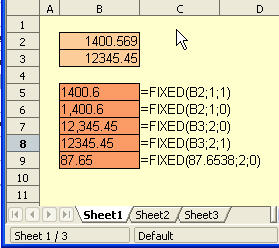
This entry was posted on Sunday, September 25th, 2005 at 11:35 am and
Paste Special II - Removing formulae
September 20th, 2005
The paste special feature is useful for preserving the values in a spreadsheet - but removing the formulae that generated those values. This may be required to preserve proprietary equations.
To remove the formulae for a range of cells, select and copy the desired range. Do not unselect the range. Now click on Edit - Paste Special - see below.
Make sure the Formulas box is unchecked. After you click OK, the formula is removed but the value is preserved.
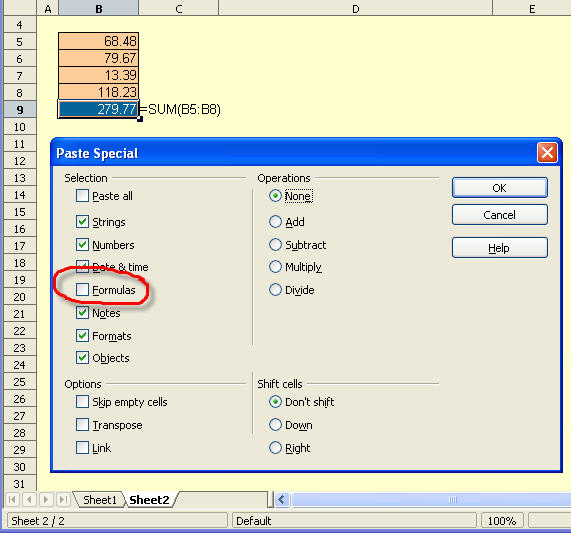
Posted in Using OpenOffice Calc | No Comments »
Secret StarWars games
September 16th, 2005
Open Office Calc has an interesting Easter egg - a hidden feature that might not be obvious or documented. Programmers sometimes bury Easter Eggs in their programs or web sites to add extra depth and challenge users to find them.
In an empty cell, type the following formula..=GAME(”StarWars”) This is what you will see…
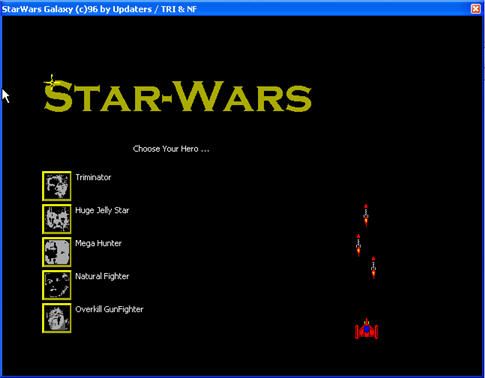
After you have selected your hero, the game begins. Another screen shot…
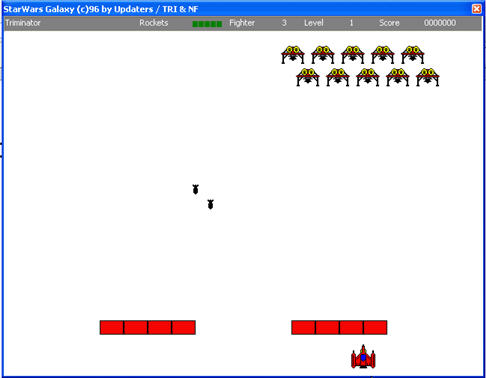
You can only play the game once. To play again - exit OOo Calc and the quickstarter before restarting.
Posted in Using OpenOffice Calc | No Comments »
Using Names as constants
September 15th, 2005
There are many mathematical and statistical constants in use that are needed in spreadsheets. For OpenOffice Calc, only PI has been hardwired as a function call - PI()
Using defined names is a quick and easy way to define constants in your spreadsheet that will also make your formulae more legible and maintainable. There will also be no need to have hidden sheets where the constants are defined. In this example, we will define Euler’s constant - e
Open the Define Names dialog as shown below.
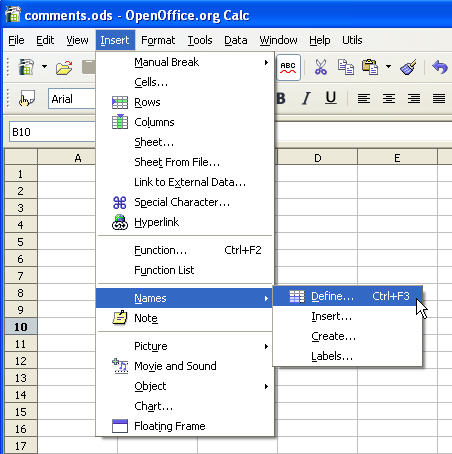
Instead of assigning/associating the name with a particular cell, assign a fixed value as shown below. Exit the dialog
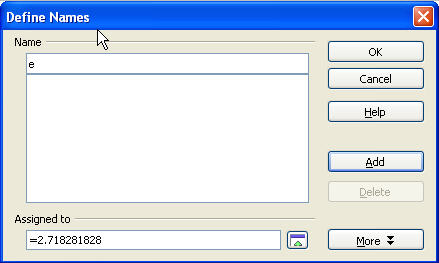
The named constant can now be used in formulae as shown below. Note that Names defined in this way do not appear in the name box - which is just above the cells area on the left.
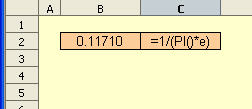
Posted in Using OpenOffice Calc | 1 Comment »
Listing Cell Notes
September 14th, 2005
Here is a simple macro that creates a new sheet in the Calc document with a listing of all the notes (comments) found.
Notes can be added to any cell with Insert - Note - see below.
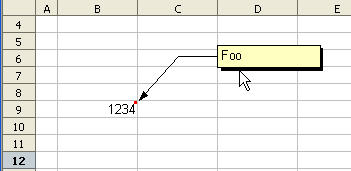
The Basic code for gathering all of these notes and adding them to a new sheet is given below. Items in the listing I’d like to draw your attention to..
Creating new sheets with the insertNewByName method.
The PrintableAddressOfCell and ColumnNumberToString routines convert row and column cell offsets to human readable notation - and were written by Andrew Pitonyak.
The notes (annotations) for each sheet are traversed using a For loop in the exact same way as the sheets of the document.
Sub AddCommentSheet
Dim oSheets, oSheet Dim oRange, oCell Dim oAnnotations, oNote Dim i As Integer Dim j As Integer
oSheets = ThisComponent.Sheets
oSheets.insertNewByName (”Comments”, oSheets.getCOunt())
oSheet = oSheets.getByName(”Comments”)
oRange = oSheet.getCellRangeByName(”B1:C1″) oRange.merge(True)
oCell = oSheet.getCellByPosition(1,0) oCell.setString(”Comment listing”) oCell.CellBackColor = 16764057 oCell.HoriJustify = com.sun.star.table.CellHoriJustify.CENTER
oCell = oSheet.getCellByPosition(1,1) oCell.setString(”Created on …” & Now())
oCell = oSheet.getCellByPosition(1,3) oCell.setString(”Sheet”) oCell.CellBackColor = 16764057 oCell = oSheet.getCellByPosition(2,3) oCell.setString(”Cell”) oCell.CellBackColor = 16764057 oCell = oSheet.getCellByPosition(3,3) oCell.setString(”Note”) oCell.CellBackColor = 16764057
CurRow = 4 For j = 0 To oSheets.getCount()-1 oSheet2 = oSheets.getByIndex(j) oAnnotations = oSheet2.getAnnotations()
For i = 0 To oAnnotations.getCount()-1 oNote = oAnnotations.getByIndex(i) oCell = oSheet.getCellByPosition(1,CurRow+i) oCell.setString(oSheet2.Name) oCell = oSheet.getCellByPosition(2,CurRow+i) oCell.setString(PrintableAddressOfCell(oNote.getParent()) oCell = oSheet.getCellByPosition(3,CurRow+i) oCell.setString(oNote.getString()) Next CurRow = CurRow + i Next
End Sub
Function PrintableAddressOfCell(oCell) As String If IsNull(oCell) OR IsEmpty(oCell) Then PrintableAddressOfCell = “Unknown” Else PrintableAddressOfCell = ColumnNumberToString(oCell.CellAddress.Column) &_ Cstr(oCell.CellAddress.Row+1) End If End Function
Function ColumnNumberToString(ByVal nColumn As Long) As String Dim s As String Do While nColumn >= 0 s = Chr$(65 + (nColumn MOD 26)) & s nColumn = nColumn \ 26 - 1 Loop ColumnNumberToString = s End Function
The newly created comment sheet is shown below.
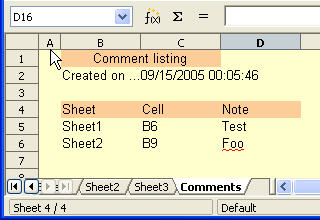
Posted in OpenOffice Basic | No Comments »
